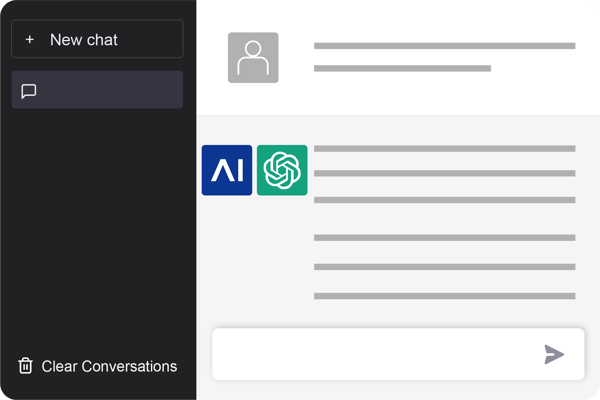The joy of the holidays means kindness, pleasant exchanges, and well wishes - unless you work in customer service. No season brings forth more misery than the holidays when stressed customers make verbal punching bags of customer service teams.
Most customer service teams roll into the holidays braced for a barrage of complaints about long wait times, out of stock items, allegedly rude employees, and more. It’s a veritable nightmare that should elevate your customer service teams to sainthood, though we know it doesn’t.
Dealing with unhappy customers during the holiday rush often leads to call-offs and high turnover. Thankfully, a new AI trend could revolutionize the way we handle customer service, including those frightful holiday interactions.
The customer service dilemma
Customer service call centers provide businesses with the opportunity to connect with their audience. In turn, customers have the opportunity to seek assistance and voice dissatisfaction with the brand or a particular experience.
Inevitably, some of the angry customers request to speak with a manager. Simply speaking with a manager diffuses some angry customers. For others, explaining the issue a second time or correct misinformation is enough to send them over the edge.
Recording customer service calls is one way to monitor feedback on your brand and products. It allows you to review your team’s interactions and gather opinions. Your team can escalate calls to management as needed. You probably even have a quality assurance team to review exchanges and provide feedback.
If this model works for you, that’s great! However, if you’re one of the many businesses losing customers and facing negative reviews focused on your customer service team, you need answers.
The value of recorded calls
Recorded customer service calls provide a wealth of information. There are two common problems facing businesses that want to learn from recordings.
- Finding the resources to review every call.
- Determining the vital information in each recording.
Think about it and consult with your QA team. How many customer service calls does QA actually monitor? Even if your team reviews an above-average number of calls, it’s still probably a fraction of what your customer service agents take. That’s a lot of data left undocumented!
Of the calls reviewed by quality assurance, how much information reaches management? Further, consider what actions management takes in response to the information they receive. If they manage the individual complaint and then file it away without another thought, it’s a missed opportunity.
The truth is, there’s a lot of information to glean from recorded customer service calls, especially those that garner complaints about your company. Hiring enough people to help your QA team review every call from your customer service team is costly and unnecessary. AI technology offers an efficient, cost-effective solution to your problem.
The challenge of managing live calls
Live calls pose an entirely different challenge, especially during the holiday rush. Representatives face an alarming number of calls, many of them angry, frustrating, and desperate to get their point across.

How long do you suppose it takes for a customer service rep to tune out a dissatisfied customer? When that happens, the agent may miss things that the customer feels are important, leading to further escalation.
Then, what happens when your team can’t immediately accommodate everyone? Usually, tempers flare, and the situation escalates again. Maybe you don’t have enough management to handle the calls, and people have to wait longer.
Resolving complaints promptly is challenging on a regular day, but you need all the help you can get during the holiday season! Again, AI technology could be the answer you (and your team) need.
Changing the face of customer service
How do you know you’re dealing with an unhappy customer? Many cues tip us off to anger and frustration, even if we can’t see the other person’s face. Typically, three primary verbal cues that can alert us to anger or frustration over the phone.
- Speech rate changes may vary across cultures, but the typical talking speed is 120 to 150 words per minute. When people speed up or slow down their speech, it’s often indicative of a problem.
- Speech volume is an easy one. If somebody is yelling, they’re probably not pleased.
- Sentiment may seem intangible, but word choice and tone often provide cues about how a person feels.
It takes a degree of training for people to learn how to interpret these three metrics. After all, you don’t hire somebody who’s never done customer service calls to take on a management role. Those positions go to people who have proven their ability to handle demanding customers and diffuse situations.
AI-based speech analytics bypass some of that learning curve by using established algorithms to process a call’s tone in seconds. Beyond the three main metrics, AI can monitor for keywords in calls, like “sorry.”
Not only can you use AI to analyze recorded calls, but the technology can also work wonders on live calls. That means you can sift through recorded calls to harvest data for tracking while monitoring live calls to expedite escalation, response time, and resolution for a positive outcome.
Benefits of using AI to support your customer service team
AI can ease the burden on your team as they navigate the holiday season. You may be surprised by the depth of information and assistance you get from the advances in AI technology.
1. Improved feedback
Consider your current system and the number of satisfaction surveys you receive. Even if you receive a decent number, there’s a strong possibility that you missed out on several dissatisfied customers who simply refused to respond.
AI monitors the call, so you don’t need the follow-up survey to tell you if a customer was unhappy. In short, AI-based analytics provide better, more comprehensive feedback that you can use.
2. Better quality review
Quality assurance teams can’t possibly monitor everything at all times. With AI to pick up the slack, you can expect a notable bump in quality review, which helps your team improve. Plus, AI can handle real-time or recorded calls depending on your team’s needs.
3. Faster response times
Since AI-based speech analysis has some predictive elements, it can assess signs of escalation or pick up specific keywords indicative of a problem. Further, the AI tech can alert managers in real-time. Consequently, your management teams can prepare for a call to be transferred and handle dissatisfaction faster.
Imagine how a frustrated or angry customer would respond if the manager picked up and already knew about the situation. What if the manager also offered a viable solution? AI-based virtual agents can arm your team with helpful information and provide them time to prepare, even during the holiday rush.
TIP: The following video is an example of how efficient a virtual voice agent can be without the need for a human agent.
4. Creates a comprehensive customer complaint center
AI technology can collect information from every platform you use and analyze it. You can effectively monitor calls, chats, and social media posts for signs of dissatisfaction in a fraction of the time it would take your human employees to comb through and respond to the complaints.
Since AI streamlines the dissatisfaction from multiple sources, your team can respond faster to the most critical comments and issues. The AI-gathered data can identify patterns of complaints about a product or service faster as well.
5. Efficient chatbots alleviate traffic
AI chatbots are standard practice for many organizations. A basic AI interface can manage low-level and common questions, which leaves your human employees to handle more complex issues. Sure, it takes the strain off of your team, especially during those high-traffic holidays, but what does that basic AI miss?
When AI chatbots employ speech analysis and keyword searches, you get a more organic exchange. You can even personalize the interactions to sound more in line with your brand’s voice. A personalized response from a chatbot may give even the angriest customer a feeling of being heard. That possibility is invaluable in terms of customer services.
6. Data mining
You can gather a plethora of information from customer feedback and complaints. Even positive responses can provide insight into how the public views your brand. Using AI to collect, refine, and analyze the records helps you streamline services and make changes to improve products, messages, and more.
Using AI to ease dissatisfaction during the holidays and beyond
While everyone loves accolades, it’s more important to consider complaints from dissatisfied customers. People willing to tell you what you can improve on offer you the most room to grow.
Unfortunately, there’s a lot more negative feedback during the holiday rush, and your customer service team is only human. Embracing AI technology to assist them during the busy season (and beyond) can help your team perform better and improve your company’s bottom line.
Tools like AI-based virtual voice agent can be an invaluable resource for your team. They can handle common questions to reduce the inbound call volume, help managers identify escalating calls earlier, and provide your team with accurate analytics. Imagine how much more effective your team can be during the holiday rush and beyond.
If you want to explore your AI customer service options, contact us to book a demo!

.png?width=60&height=60&name=AI%20Copilot%20logo%20(mega%20menu).png)




.png?width=600&height=600&name=Knowledge%20AI%20Feature%20image%20(2).png)













